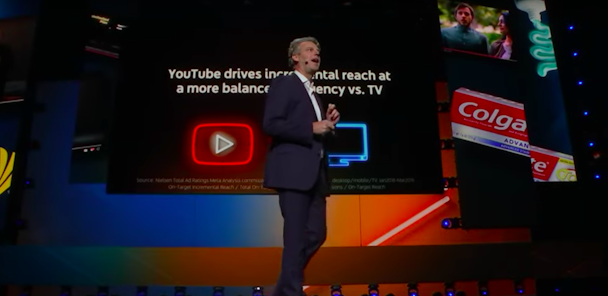YouTube looking more like TV as it adds Nielsen data to Reach Planner
YouTube wants to attract ad dollars away from TV, so it’s turned to Nielsen for help.

Google Americas president Allan Thygesen touts YouTube's incremental reach at Brandcast 2019
The Google-owned video platform is integrating Nielsen TV data into Reach Planner, its audience planning tool within Google Ads launched last April.
Brands are starting to use Google data from Reach Planner to help find audiences fleeing traditional TV, signaling a shift that YouTube isn’t just a targeting play for advertisers.
Kristin MacGregor, US director of video for YouTube, said many ad agencies are using Reach Planner to estimate unique reach for big campaigns. Now with the option of planning against Nielsen TV demographics, MacGregor said brands can compare YouTube and TV reach on an “apples to apples” basis.
“With Nielsen TV data directly available in Reach Planner, brands can compare how different distributions of spend on TV and YouTube influence the overall reach and frequency of a particular campaign,” said MacGregor.
YouTube also uses Nielsen Total Ad Ratings for post-campaign measurement. By adding Nielsen data to the mix upfront, YouTube is essentially speaking the language of big-budget TV buyers from start to finish.
Google has already been selling Google Preferred inventory on a TV-like CPM basis, which has expanded to include YouTube TV inventory. YouTube also has a new Instant Reserve tool that mimics an upfront TV buy. Plus, YouTube has brought non-skippable 15-second ads to Google Ads and Display & Video 360 auctions.
Google essentially wants to bring more YouTube inventory under its control within its auctions, and borrow familiar TV buying practices to attract upper funnel, big brand advertisers.
Charlie Chappell, head of integrated media and communications planning at The Hershey Company, said the brand sees YouTube as a reach play first, and a targeting play second.
“We've viewed YouTube as a TV-like environment for some time,” said Chappell.
“Because [YouTube] has a different set of content than what's available in traditional TV, it attracts a different audience for a different occasion, and so it's good for us to be a part of our total mix because those are the people that, a lot of times, we couldn't reach otherwise.”
YouTube does have its track record of brand safety crises to contend with if it wants to woo advertisers away from the trusted, premium TV environment. Chappell, though, said YouTube’s quality of content isn’t a “black and white issue”.
“There is, in general, that quality of content [compared] to the price that I paid for the audience that it attracts,” said Chappell. “What we've seen is YouTube is priced appropriately within the marketplace to where it works for us and becomes a meaningful part of the mix that we have.”
Nielsen TV data within Reach Planner is currently only available in the US. Google is planning a global roll-out next year.
Forecasting in Reach Planner doesn’t extend to inventory within YouTube TV, Google’s virtual pay-TV product.
Chappell said Hershey will evaluate results after it’s launched a handful of campaigns as the option of planning against Nielsen TV data is more of a “nice to have” – for now.
“The landscape changes so quickly that my answer could be different in two years,” said Chappell.
